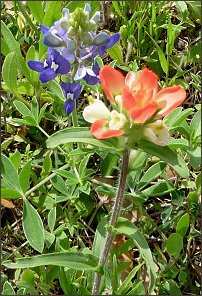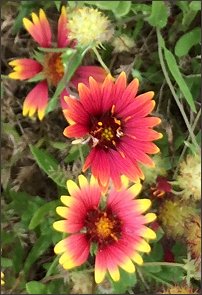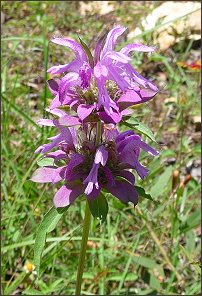|
The Canyon Lake area of Central Texas is traditionally dry, scorching hot in the summer, and has very little topsoil over limestone. It also is overrun with deer, deer, and more deer! So-called deer-resistant landscape plants and wildflowers can turn into deer snacks quickly depending on what your local herd likes to eat. I spent weeks on the internet researching wildflowers suitable for the climate and resistant to critters – my long list of “gotta have these in the yard” started shrinking smaller and smaller as this one was marked off as needing far more rain than our average or that one was a favorite tidbit for deer. I contacted Wildseed Farms and they helped finalize my list. The first year, on a ½ acre of land, we spread a 12# mix with 17 different kinds of seed, plus a couple pounds of Texas-Oklahoma Mix containing 11 more kinds. Amazingly, despite a horrible drought, quite a few came up, however, I quickly discovered which ones wilted in the heat or disappeared after deer wandered through the yard. The second year, we expanded to an acre of our lot and put out 17 kinds, but substituted some that we had not tried before or that came up from the TX-OK mix – we had MUCH better results! Plus, we increased the amount of seed to 30# going heavy with what seemed to do best in our yard, namely Texas Bluebonnets, Texas Paintbrush, Indian Blanket, and Lemon Horsemint.
Sowing the seed was a whole ‘nother matter! After reading a lot of information and getting ideas from folks who'd done this before, we started with a blend of sand, peat-based potting soil, and seed in equal parts. We had a yard whirly-spreader that hubby used, but found that the sand ran out first, the seed clumped, and the peat moss stuck! What a mess that was. Somehow, we managed to get all the seed out, but needed to find a better way for the next year. The second year, we used two parts kitty litter to one part seed and it flowed perfectly through the yard spreader. I also hand spread some extra seed in various parts of our yard still using two parts kitty litter to one part seed mix. Note: If you buy a seed blend, or do your own blend – be sure to mix, mix, mix! Small seed sifts to the bottom and big seed floats to the top when bagged together. Before we get started, I turn the bag of mix over and over, shaking and kneading it. Then I divide our seed blend into 2# portions, put that in a 2 gallon zip lock bag with about a quart of kitty litter and shake, rattle, and roll it. I then add it to two parts kitty litter mixed thoroughly in a big bucket before going into the spreader. Oh, I almost forgot to tell you how we prepare the yard before seeding. We simply mow and put the seed out. Granted we might have more seed sprout if we go to all the trouble to scrape, rake, and roll, but on an acre of land, it would be a major project. Plus, think about it… how does Mother Nature do it? Well, the seed drop off the plants in the spring or summer, fall on the ground and sprout the next year. Which leads to…. THE SECRET TO GROWING ANYTHING SUCCESSFULLY is to mimic Mother Nature. for instance, if there's a drought and you want your wildflowers to grow beautifully, you may have to water them… just like if there wasn't a drought and Mother Nature was doing it for you by actually raining once in a while. (Can you tell that I'm tired of the long lasting droughts?) In the Canyon Lake area, seed can go out in mid to late September and will hopefully catch some rains. October isn't too late, but be sure to sow seed before Halloween.  In
October or November, you may notice bluebonnets coming up – look for the
distinctive two oval seedling leaves. It will slowly grow roots during
the winter in preparation for spring blooms. You may see other types
of seed such as Plains Coreopsis sprouting here and there – it important
to know the “friendlys” (wildflowers) verses the “foes” (winter weeds). In
October or November, you may notice bluebonnets coming up – look for the
distinctive two oval seedling leaves. It will slowly grow roots during
the winter in preparation for spring blooms. You may see other types
of seed such as Plains Coreopsis sprouting here and there – it important
to know the “friendlys” (wildflowers) verses the “foes” (winter weeds).
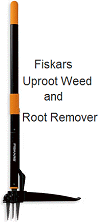 Over
the winter, watch for cold weather weeds and in our case, the dreaded Mexican
Hat wildflower that is trying to take over our yard and choke out the ones
we want! A MUST for pulling weeds is the Fiskars Uproot Weed and
Root Remover – easy to use and very effective. You can order it from
Amazon if you can't find it at your local garden center. Just position
the bottom prongs over the weed, step on the foot plate to push it down,
slide your foot halfway back, and gently rock the handle back - instant
weed puller! Over
the winter, watch for cold weather weeds and in our case, the dreaded Mexican
Hat wildflower that is trying to take over our yard and choke out the ones
we want! A MUST for pulling weeds is the Fiskars Uproot Weed and
Root Remover – easy to use and very effective. You can order it from
Amazon if you can't find it at your local garden center. Just position
the bottom prongs over the weed, step on the foot plate to push it down,
slide your foot halfway back, and gently rock the handle back - instant
weed puller!
In the spring and summer, hubby also uses RoundUp to control weeds but is very, very careful to avoid wildflowers coming up. We also use Ornamec herbiside spray to control grasses – it will not effect wildflowers but WILL kill off unwanted grasses that tend to nudge out wildflowers. Amazon has Ornamec for sale as does Wildseed Farms online catalog. The easiest way to start a yard of wildflowers is to buy a prepared blend “brewed” by one of the wildflower farms. The closest to what we have found to be resistant to deer and drought for the Canyon Lake area of the hill country is “Lady Bird’s Legacy Wildflower Mix” available at Native American Seed in Junction, Texas. Its website has this and various other mixes available along with many different kinds of individual seed. Wildseed Farms in Fredericksburg and its website also offers seed and mixes - the All Native Texas/Oklahoma Mix might be worth trying if you don't have resident deer. 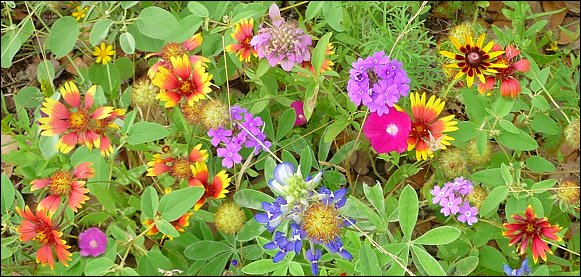 In most cases, a pound of pre-blended seed mix will cover 2000 sq. ft. of area and the cost varies from $35 to $45. Smaller amounts can be purchased – a packet for about 20 sq. ft. and ¼ pound for 500 sq. ft. If you want to know more about doing your own mix and have at least an acre of land to grow wildflowers on, take the link below to WILDFLOWER SEED & MIXES. |
